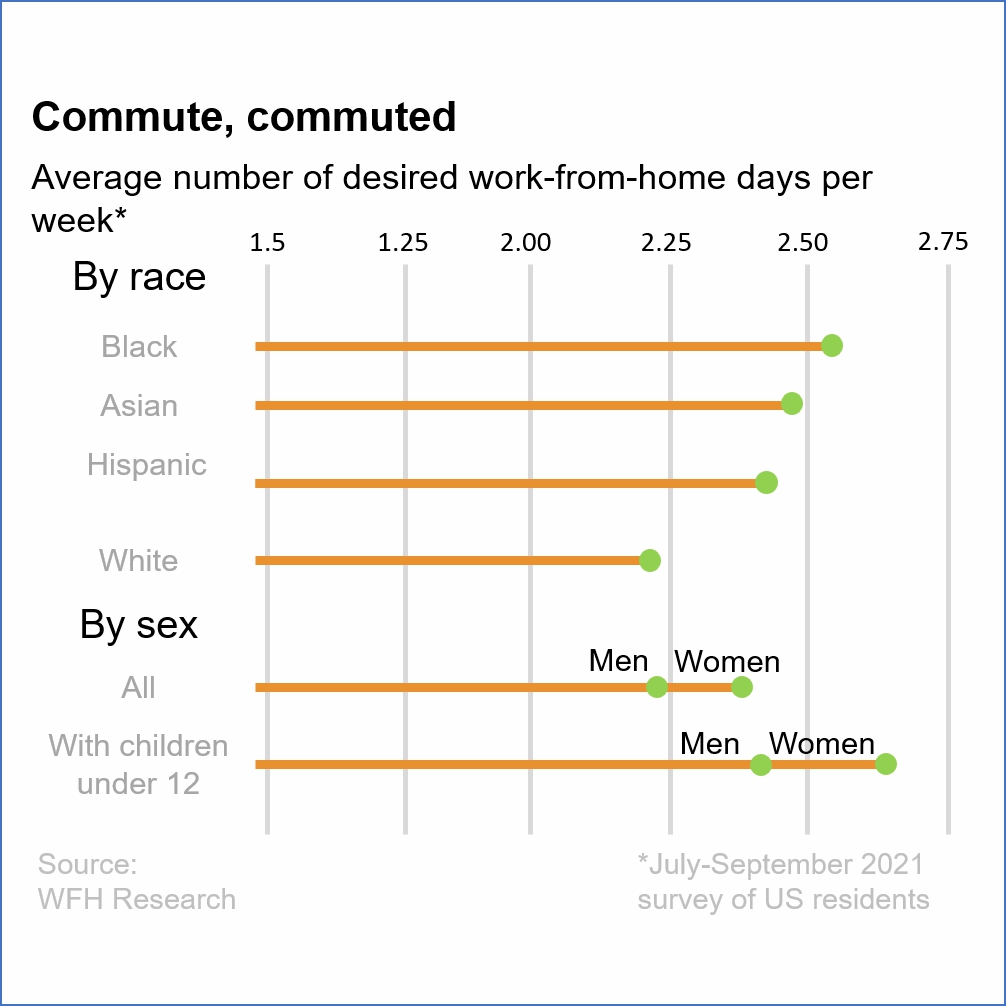Hybrid work model: work from home future

Please find hereby a review of the labor market trends based on WFH Research, Glassdoor and The Economist Investigations.
An office in the living room or kitchen increases the level of satisfaction
The COVID-19 lockdowns were an unprecedented shock for office life. Companies around the world have been forced to join a giant experiment – the transition to distance working. Few of them would dare to try this format on their own. But at the peak of the pandemic, about 60% of all working time in America was spent in living rooms and kitchens.
It was not easy to adapt to the new regime, especially for residents of small apartments or parents of pupils who also studied remotely. However, the average employee reports a higher level of satisfaction and happiness. Respondents also admit that they would like to work from home for about 50% of the time and spend the rest of the working hours in the office. But the real behavior of people suggests otherwise: in fact, they want to stay in comfortable home pajamas even longer. How else can be explained the fact that offices are still filled only by one third?
By 2022, many companies are realizing that they need to work harder to encourage employees to come to the office. This means investing in additional benefits such as fitness center passes or employer-paid delicious lunches. And governments are beginning to realize that labor law needs to be updated to recognize and protect the rights of remote workers… It means, there are many issues that need to be improved.

Absence of favoritism and availability of justice
Increased productivity, happier and healthier workers and reduced carbon emissions are just some of the benefits of a great experiment with working at home. Another expected advantage is more justice at the workplace. Those concerned with inclusiveness and diversity of staff hoped that the pandemic would be a “great equalizer” as workers were stuck at home and appeared during video calls in random rectangles of the same size without being able to flatter bosses in the office. This finally had to remove the stigma from distant work and give all employees an equal chance of success.
Justice – for all intents and purposes, the lack of favoritism – is easier to track when everyone works in similar conditions.
But a few company executives are enthusiastic about the prospect of remote work on such a large scale, being worried about productivity. After all, even in rich countries, the majority of the workforce shall be physically present to do the job. The gap between high-paid intellectuals on the one hand and low-paid service workers on the other began to form long before the pandemic. Growing scale of work from home widens the gap between these two categories – and no one can predict the consequences of such sequence of events.
Hybrid workplace. Maybe this is the way out?

In contrast to the full distance work, there are fewer conflicting opinions regarding the hybrid approach. After all, a combination of remote work and office work can actually be the most effective mechanism for increasing productivity. It allows for a more rational distribution of complex work: one that requires considerable concentration and is better to be done at home, and one that is better to be done with colleagues in the office.
In addition to efficiency, some companies recognize the importance of a hybrid format in the fight to retain talented people.
But during the transition to a hybrid work schedule, managers will need completely different skills. If companies used to hire and promote charismatic leaders, now they need to rely on executives who have mastered digital tools and are able to clearly determine what to do and when to work with remote teams. In addition, both enterprises and the work itself will become more active in the digital format.

In the United States, 5% of work was performed remotely before the pandemic, and 27% of employers offered a flexible schedule; today these figures are 40% and 88% respectively. And there is the evidence that the transition to hybrid work is being compensated. Data from Glassdoor, a website with employee ratings for their employers, shows that during the pandemic, people were more positive about their companies’ corporate culture because they were more flexible.
But…
But if you leave the hybrid work environment to develop naturally, it will increase existing inequality rather than reduce it. This is due to the fact that employees have different preferences for office work, and such differences do not arise by chance.
Thus, if they have a choice, women or parents with young children will spend less time in the office. They will pay for this by not raising salaries and promotions, because employers (often subconsciously) value physical presence.
If the employer insists on full-time employment in the office, women are also more likely to quit. There may be teams with two levels of payment – higher for the “inner” group and lower for the “outer” group.
To avoid this, employers need to organize a quality workspace.

Workspace: features of hybrid work arrangement
Firstly, managers need to determine whether they need procedural justice (uniform rules for everyone) or fairness in the end (when no group suffers as a result of policies).
Secondly, employers will need to be honest with themselves about whether physical presence really adds value. It is pointless to combine the concepts of physical accessibility and productivity and reward employees in an appropriate manner.
It is even more important to clearly express your position to employees. Apple has been criticized for requiring employees to return to the office and work there three days a week, but at least the company has set the clear regulations. Many employers promise the opportunity to work on a flexible schedule, but in the end employees have to decipher the unwritten laws. In today’s hot labor market, such promises are understandable, but they are senseless without clarity.
Companies that promise not to punish remote workers need to provide them access to the same resources that everyone else uses. It also involves investing in fair processes.
Those companies that value physical presence should consider setting fixed days in the office. Leaders can help lower attendance points by working from home on optional days, or by emphasizing that on some days everyone will work from home.
Employers who demand a full-time return to the office will lose valuable staff and are likely to lose the variety. A survey by WFH Research demonstrated that under such circumstances, the risk of escaping is relevant for 39% of men and 48% of women.

Risk for some and opportunity for others
The risk of losing staff for one company is an opportunity for another. Now that many jobs can be done on a flexible schedule or completely remotely, the range of new recruiters for employers has expanded. According to one study, the offer for a flexible schedule in the job advertisement increased the number of applications by as much as 30%. It should also help with staff retention.
Of course, technology has reduced the cost of distant work, and at the same time partially removed the stigma from it. However, so far there is little evidence of the establishment of the expected “Zoomocracy” (from the name of the video conferencing service Zoom), which will allow you to hear all the voices equally well. One third of women surveyed in the field of technology admitted that they were interrupted or ignored more often during the virtual meetings than during the personal ones.
Men are almost twice as likely as women to say that working from home has had a positive effect on their careers. Those who care for their relatives are less likely to succeed. And newcomers have lost an important opportunity to learn and expand the circle of acquaintances in the workplace. Every employer who wants to start with dignity in the hybrid world shall first understand how to regain their position after the crisis and make up for lost time.
Why 2022 is the year of the average worker
Experts estimate that in 2022 people will spend about five times more time outside the office than before the lockdown. This will increase the feeling of happiness and productivity.
The second factor concerns automation. Many economists assume that the pandemic will start the active use of robots, and jobs will move to machines controlled by artificial intelligence. However, according to an analysis by The Economist, too rapid automation is currently not happening. The number of jobs where work could be mechanized is growing as fast as the number of other vacancies.
The third factor concerns policy. Against the background of the pandemic, politicians and financiers have become more interested in reducing unemployment than in reducing inflation or public debt.
As a result, workers are now in a much better position than ever before when it comes to defending their interests. In America, the monthly number of voluntary redundancies is close to the all-time high. It is difficult for employers who offer low wages or not very good working conditions to fill vacancies. In rich countries, the vacancy rate is at a record high of 30 million. But for most of the past decade, the last word has been with companies. So, you should not be afraid of the year of the worker.